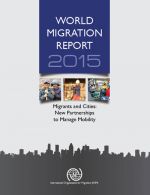World Migration Report 2015 – Migrants and Cities: New Partnerships to Manage Mobility

The World Migration Report 2015 takes migration enquiries to the city level. It aims to increase understanding of the local socioeconomic dynamics of migration and the close connection between migration and urban development.
Many cities and local governments still do not include migration or migrants in their urban development planning and implementation. Migrants are therefore still generally overlooked in global discourses on urbanization and cities. However, migration to cities is on the rise. For cities everywhere, diversity is a reality of urban life and has to be factored into governance and development policies as internal and international migration continues to increase.
This report aims to address this challenge in three distinct ways:
• By documenting how migration is shaping cities and the situation of migrants in cities. Much of the current international discussion about migration trends and migration policy tends to focus on the national level. Examining the city level increases our understanding of the local political economies of migration.
• By drawing attention to the livelihood of migrants in the cities of the global South. The existing discussions on migrants and cities tend to focus primarily on the global North and the integration of international migrants.
• By examining both internal and international migration. Cities across the development spectrum have increasingly mobile and diverse populations to manage. In developed countries, one of the main sources of population diversity is international migration, while in the developing world it is most likely internal migration and, to a lesser extent, growing international South–South migration.
Migration to cities brings both challenges and opportunities. This report highlights how cities and migrants can work together in order to reduce the risks of migration to cities and take advantage of growing urban diversity in such areas as community resilience building and local development, through migrants’ connections between origin and host communities. It argues that migrants are resourceful partners in urban governance. They make significant and essential contributions to the economic, social and cultural development of their host countries and of their communities back home. They can be builders of resilience, agents of local development, and city-makers.
Furthermore, the International Organization for Migration shows that urban growth can be sustained when cities invest in their people. Partnerships with migrants and their inclusion are seen as an essential part of urban governance, and engaging in partnerships increases the social cohesion and competitiveness of cities.
The report concludes with a set of recommendations for future city initiatives to include migrants as partners and to include migrants’ issues in the discussion on urbanization and the post-2015 global development framework.
Book note prepared by Lina María Rosales
Search the Book notes database
Our Book notes database contains details and summaries of all the publications included in Book notes since 1993 - with details on how to obtain/download.
Use the search form above, or visit the Book notes landing page for more options and latest content.
For a searchable database for papers in Environment and Urbanization, go to http://eau.sagepub.com/

